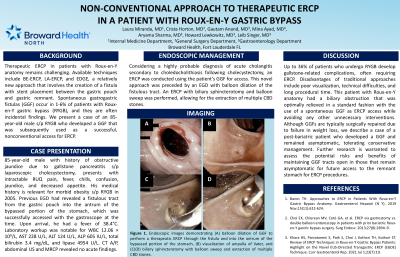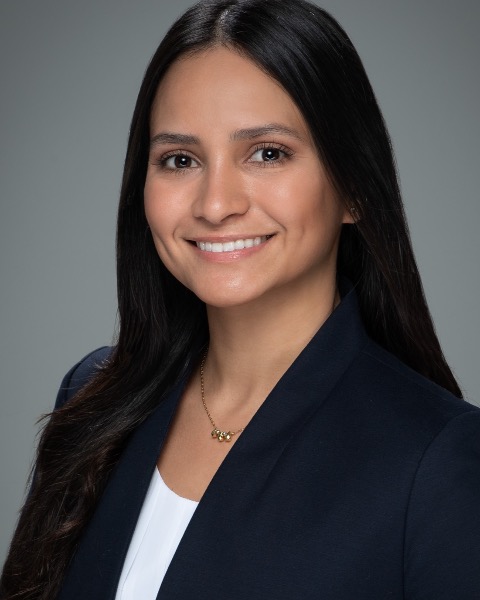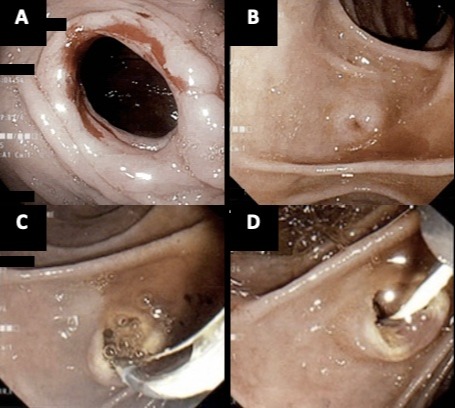Tuesday Poster Session
Category: Interventional Endoscopy
P4514 - Non-Conventional Approach to Therapeutic ERCP in a Patient With Roux-en-Y Gastric Bypass
Tuesday, October 29, 2024
10:30 AM - 4:00 PM ET
Location: Exhibit Hall E

Has Audio

Laura Miranda, MD
Broward Health North
Pompano Beach, FL
Presenting Author(s)
Laura Miranda, MD1, Crista Horton, MD2, Gautam Anand, MD3, Mina Ayad, MD3, Aryama Sharma, MD3, Howard Lewkowitz, MD2, Leib Singer, MD2
1Broward Health North, Pompano Beach, FL; 2Broward Health, Fort Lauderdale, FL; 3Broward Health North, Fort Lauderdale, FL
Introduction: Therapeutic ERCP in patients with Roux-en-Y anatomy remains challenging. Available techniques include BE-ERCP, LA-ERCP, and EDGE, a relatively new approach that involves the creation of a fistula with stent placement between the gastric pouch and gastric remnant. Spontaneous gastrogastric fistulas (GGF) occur in 1-6% of patients with Roux-en-Y gastric bypass (RYGB), and they are often incidental findings. We present a case of an 85- year-old male s/p RYGB who developed a GGF that was subsequently used as a successful, nonconventional access for ERCP.
Case Description/Methods: 85-year-old male with history of obstructive jaundice due to gallstone pancreatitis s/p laparoscopic cholecystectomy, presents with intractable RUQ pain, fever, chills, confusion, jaundice, and decreased appetite. His medical history is relevant for morbid obesity s/p RYGB in 2005. Previous EGD had revealed a fistulous tract from the gastric pouch into the antrum of the bypassed portion of the stomach, which was successfully accessed with the gastroscope at the time. Upon arrival, he had a fever of 38.4°C. Laboratory workup was notable for WBC 12.06 × 109/L, AST 228 U/L, ALT 124 U/L, ALP 605 IU/L, total bilirubin 3.4 mg/dL, and lipase 4954 U/L. CT A/P, abdominal US and MRCP revealed no acute findings.
Considering a highly probable diagnosis of acute cholangitis secondary to choledocholithiasis following cholecystectomy, an ERCP was conducted using the patient’s GGF for access. This novel approach was preceded by an EGD with balloon dilation of the fistulous tract. An ERCP with biliary sphincterotomy and balloon sweep was performed, allowing for the extraction of multiple CBD stones.
Discussion: Up to 36% of patients who undergo RYGB develop gallstone-related complications, often requiring ERCP. Disadvantages of traditional approaches include poor visualization, technical difficulties, and long procedural time. This patient with Roux-en-Y anatomy had a biliary obstruction that was optimally relieved in a standard fashion with the use of a spontaneous GGF as ERCP access while avoiding any other unnecessary interventions. Although GGFs are typically surgically repaired due to failure in weight loss, we describe a case of a post-bariatric patient who developed a GGF and remained asymptomatic, tolerating conservative management. Further research is warranted to assess the potential risks and benefits of maintaining GGF tracts open in those that remain asymptomatic for future access to the remnant stomach for ERCP procedures.

Disclosures:
Laura Miranda, MD1, Crista Horton, MD2, Gautam Anand, MD3, Mina Ayad, MD3, Aryama Sharma, MD3, Howard Lewkowitz, MD2, Leib Singer, MD2. P4514 - Non-Conventional Approach to Therapeutic ERCP in a Patient With Roux-en-Y Gastric Bypass, ACG 2024 Annual Scientific Meeting Abstracts. Philadelphia, PA: American College of Gastroenterology.
1Broward Health North, Pompano Beach, FL; 2Broward Health, Fort Lauderdale, FL; 3Broward Health North, Fort Lauderdale, FL
Introduction: Therapeutic ERCP in patients with Roux-en-Y anatomy remains challenging. Available techniques include BE-ERCP, LA-ERCP, and EDGE, a relatively new approach that involves the creation of a fistula with stent placement between the gastric pouch and gastric remnant. Spontaneous gastrogastric fistulas (GGF) occur in 1-6% of patients with Roux-en-Y gastric bypass (RYGB), and they are often incidental findings. We present a case of an 85- year-old male s/p RYGB who developed a GGF that was subsequently used as a successful, nonconventional access for ERCP.
Case Description/Methods: 85-year-old male with history of obstructive jaundice due to gallstone pancreatitis s/p laparoscopic cholecystectomy, presents with intractable RUQ pain, fever, chills, confusion, jaundice, and decreased appetite. His medical history is relevant for morbid obesity s/p RYGB in 2005. Previous EGD had revealed a fistulous tract from the gastric pouch into the antrum of the bypassed portion of the stomach, which was successfully accessed with the gastroscope at the time. Upon arrival, he had a fever of 38.4°C. Laboratory workup was notable for WBC 12.06 × 109/L, AST 228 U/L, ALT 124 U/L, ALP 605 IU/L, total bilirubin 3.4 mg/dL, and lipase 4954 U/L. CT A/P, abdominal US and MRCP revealed no acute findings.
Considering a highly probable diagnosis of acute cholangitis secondary to choledocholithiasis following cholecystectomy, an ERCP was conducted using the patient’s GGF for access. This novel approach was preceded by an EGD with balloon dilation of the fistulous tract. An ERCP with biliary sphincterotomy and balloon sweep was performed, allowing for the extraction of multiple CBD stones.
Discussion: Up to 36% of patients who undergo RYGB develop gallstone-related complications, often requiring ERCP. Disadvantages of traditional approaches include poor visualization, technical difficulties, and long procedural time. This patient with Roux-en-Y anatomy had a biliary obstruction that was optimally relieved in a standard fashion with the use of a spontaneous GGF as ERCP access while avoiding any other unnecessary interventions. Although GGFs are typically surgically repaired due to failure in weight loss, we describe a case of a post-bariatric patient who developed a GGF and remained asymptomatic, tolerating conservative management. Further research is warranted to assess the potential risks and benefits of maintaining GGF tracts open in those that remain asymptomatic for future access to the remnant stomach for ERCP procedures.

Figure: Endoscopic images demonstrating (A) balloon dilation of GGF to perform a therapeutic ERCP through the fistula and into the antrum of the bypassed portion of the stomach, (B) visualization of ampulla of Vater, and (C)(D) biliary sphincterotomy with balloon sweep and extraction of multiple CBD stones.
Disclosures:
Laura Miranda indicated no relevant financial relationships.
Crista Horton indicated no relevant financial relationships.
Gautam Anand indicated no relevant financial relationships.
Mina Ayad indicated no relevant financial relationships.
Aryama Sharma indicated no relevant financial relationships.
Howard Lewkowitz indicated no relevant financial relationships.
Leib Singer indicated no relevant financial relationships.
Laura Miranda, MD1, Crista Horton, MD2, Gautam Anand, MD3, Mina Ayad, MD3, Aryama Sharma, MD3, Howard Lewkowitz, MD2, Leib Singer, MD2. P4514 - Non-Conventional Approach to Therapeutic ERCP in a Patient With Roux-en-Y Gastric Bypass, ACG 2024 Annual Scientific Meeting Abstracts. Philadelphia, PA: American College of Gastroenterology.
